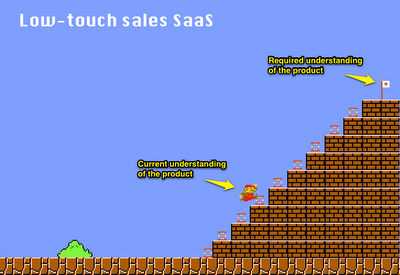To be fair, those old-school software vendors were probably able to afford having bad websites since the Internet just wasn't their primary sales or marketing channel. By contrast, if you market a SaaS application using a low-touch sales model, most of your customers will have very little interactions with your sales team, which turns your website into the face of your company. Use this as an opportunity to make your website your best marketing person!
The primary objective that your website has to achieve is clear: attract as many visitors as possible (mainly by providing great content, more on that in a later post) and turn as many of them as possible into trial users. There can be a number of secondary goals like collecting email addresses of visitors who aren't ready to start a trial yet, generating interest from and providing information for partners, informing about job openings at your company, transporting your brand image and so on, but getting visitors to try your product is clearly the most important one. As such your site needs to combine a convincing, simple value proposition, which catches the visitor's attention and makes him want to learn more, with a clear and highly visible call-to-action (hello, AIDA).
If you're new to SaaS, probably the best way to get started is to take a look at a number of successful SaaS websites. Great examples include Xero, MailChimp, CampaignMonitor, Harvest and SquareSpace. For some examples from our own portfolio, check out Zendesk, FreeAgent, Clio, Vend or Geckoboard, to name just a few. If you take a look at these and maybe other sites you'll see that they have a number of elements and characteristics in common:
- Beautiful imagery of the software (good screenshots, photos showing the app on Apple hardware) which makes you want to give it a try
- A screenshot tour and/or videos that let you easily learn more
- Brief information about the key value propositions on the homepage, with links to more comprehensive information about the product on sub-pages
- An easy to find link to a clean pricing table so that the visitor doesn't have to search for pricing information
- Quotes from customers and the press and sometimes security certificates or awards to show credibility
- Highly visible buttons for the key calls to action (usually "Sign up" and "Take the tour")
- A simple signup form with as few mandatory fields as possible in order to minimize the barrier to sign up
For an example and some additional notes, here's a wireframe that I created for my portfolio company samedi some time ago and which became a part of the briefing that we gave to the graphical designer:
(click on the thumbnail for a larger version)
Notes and bonus tips:
- Looking at existing SaaS websites and my notes above will give you a good sense for the typical anatomy of a modern SaaS site, and since a lot of thinking and often A/B testing went into them you can deduce some best practices by analyzing these sites in detail. However, this shouldn't stop you from trying your own ideas and from trying something completely new.
- Keep it simple. Just like your product needs to allow for gradual discovery, your marketing website also needs to start with a simple, compelling value proposition and keep the more detailed information for the sub-pages. Interestingly, if you look at the evolution of popular SaaS sites you'll often notice that they got simpler and simpler over time. Example: This is how Basecamp looked like in 2006, and this is how it looks like today.
- I've mentioned secondary conversion options above. It's important that you offer something to visitors who are interested in your product but aren't ready to take a trial yet. It can be a newsletter subscription, a callback button, a whitepaper download, a live chat window or signing up for a webinar, to name some options. Ideally it allows you to get the visitor's email address so that you can reach out to the user later.
- This may not be relevant for you right after the launch, but at some point in time you should try to personalize your homepage based on information that is available about the visitor and see if it has a positive effect on conversion. One simple way to do this is to customize the page based on the user's location A site like Clio, for example, could use geo-targeting to tell a visitor from, say, New York how many lawyers from New York Clio has among its customer base already or show case studies from Clio customers in New York.









